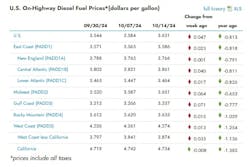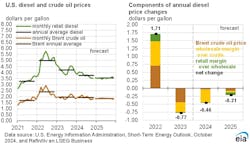Diesel price average reaches $3.63/gal, gas $3.17/gal, storm impact fleeting
In the wake of back-to-back storms in the southeast, the U.S. Energy Information Administration noticed a discernable uptick in both diesel and gas prices across the country. The national average for diesel fuel prices increased by 4 cents to $3.631 per gallon, 81 cents cheaper than this time last year.
Across the country, diesel prices continued to rise as well, with California as the sole exception. Otherwise, diesel prices rose at a rate of less than a cent to 7 cents overall. For California, diesel prices dropped less than a cent to $4.734, but the West Coast overall saw its prices rise by 1 cent to $4.274, and the West Coast without California’s diesel prices rose 3 cents to $3.874.
Unsurprisingly, the area that saw the largest diesel cost increase was the Gulf Coast, where diesel costs went up by 7 cents to $3.337. The Midwest region’s diesel costs rose 6 cents to $3.651 per gallon, and the East Coast’s costs rose 2 cents to $3.586. In the Rocky Mountain region, diesel costs increased by only one cent to $3.635. However, the Gulf Coast remains the cheapest region for diesel fuel, and California remains the most expensive.
The AAA motor club noticed this price increase as well, logging a current diesel average of $3.607 per gallon, 3 cents cheaper than the EIA’s numbers but 2 cents more expensive than last week’s average cost of $3.586. Despite this, AAA’s current numbers are 85 cents lower than this time last year.
The reason behind the rising prices could be that the arrival of autumn is putting more upward pressure on diesel prices as agricultural demands rise and refineries go into their maintenance cycles. Additionally, many are keeping an eye on the Middle Eastern conflict abroad as well as the effects of Hurricane Helene and Hurricane Milton. While the two storms have had a tremendous regional impact on fuel supply, they aren’t as likely to impact fuel costs across the country, according to Matt Muenster, chief economist at Breakthrough.
See also: Diesel prices up to $3.58/gal as Middle East tensions rise and hurricanes intensify
“It won't have a tremendous impact to diesel or gasoline prices because it didn't have an immediate impact on the infrastructure that produces or moves them,” Muenster noted. “We didn't hear about a Colonial Pipeline outage, for example, and it was far enough away from the Texas Gulf Coast that's not affecting the majority of U.S. infrastructure.”
However, the impact of the Middle Eastern conflict is a bit more noticeable in the EIA’s most recent Short-Term Energy Outlook. The Administration did note that crude oil prices have risen due to the conflict in the Middle East, which may yet cause some supply disruption.
In other news, the EIA reduced their forecast for Brent crude oil spot prices through the end of 2025, with an expectation for the average cost per barrel to hover around $78 in 2025, $7/b less than expected in last month’s STEO. This decrease in price, according to the EIA, reflects the reduced global oil demand growth in 2025.
Gas prices rise across the country, especially in the Midwest
As with diesel prices, gas costs rose across the nation, with the U.S. average currently at $3.171 per gallon, up 3 cents from a week ago and down 40 cents from this time last year. Across the various regions in the U.S., gas prices vacillated from 1-6 cents. The Rocky Mountain region was the only area which saw a decrease in costs, albeit a very marginal drop of 1 cent to $3.258.
For the rest of the country, prices rose 6 cents in the Midwest to $3.100 per gallon; 3 cents along the East Coast to $3.042; and 2 cents along the West Coast overall, the West Coast without CA, and in California. For the West Coast areas, the overall gas average reached $4.047, the West Coast without California reached $3.643, and California itself saw its gas prices reach $4.428 per gallon. Prices also rose 1 cent along the Gulf Coast to $2.735 per gallon. With these numbers in mind, the Gulf Coast is still the cheapest place for gas at $2.735 per gallon, and California is still the most expensive at $4.42.
In comparison, the motor club’s gas average is currently at $3.203 per gallon, up 2 cents from last week. Last year’s average at this time was $3.601, 40 cents higher than prices right now. The AAA also agreed on the impact of both hurricanes on regional fuel prices, and on that impact’s brevity.
“All this terrible weather lately could cause regional prices to rise as drivers flock to the few open stations with gas,” said Andrew Gross, AAA spokesperson. “But as roads are cleared and power is restored, stations will be able to be re-supplied, so any upward pressure on prices should be fleeting.”
About the Author
Alex Keenan
Alex Keenan has been associate editor for Endeavor's Commercial Vehicle Group, which includes FleetOwner magazine, since 2022. She has written on a variety of topics for the past several years and recently joined the transportation industry, reviewing content covering technician challenges and breaking industry news. She holds a bachelor's degree in English from Colorado State University in Fort Collins, Colorado.



